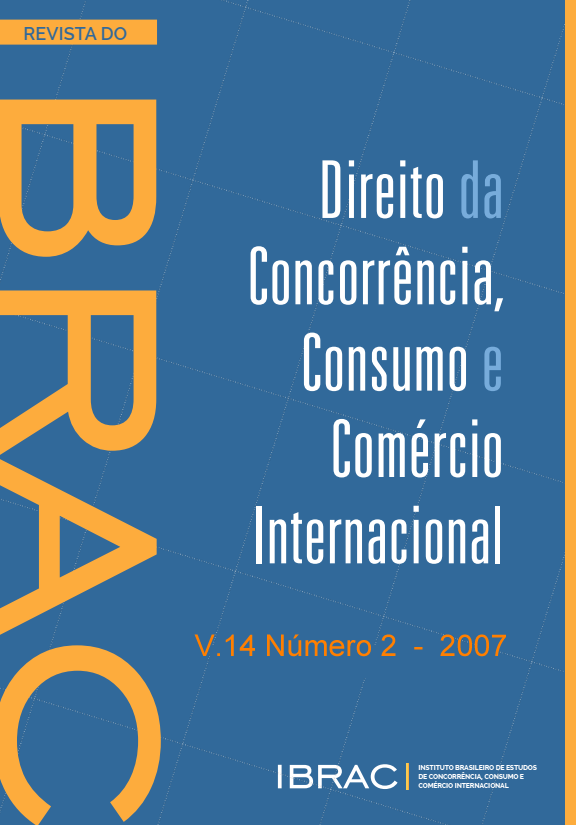Do efeito unilateral de um ato de concentração
Conteúdo do artigo principal
Resumo
Atos de concentração são considerados anticompetitivos pela “Teoria Antitruste” quando geram dois efeitos. O primeiro se refere à possibilidade da nova empresa resultante da concentração exercer poder de mercado e unilateralmente aumentar preços relativamente ao nível pré-concentração, fato conhecido como efeito unilateral (nos EUA) ou dominância de uma única empresa (Europa). O segundo se refere ao aumento da possibilidade de colusão entre as firmas do mercado, implicando um efeito coordenado (nos EUA) ou dominância conjunta (na Europa).
Downloads
Detalhes do artigo

Este trabalho está licenciado sob uma licença Creative Commons Attribution 4.0 International License.
Referências
nejamento Regional/Universidade Federal de Minas Gerais, 2005.
GEROSKI, P. Competition policy and the structure-performance paradigm. In: DAVIES, S.; LYONS, B. (Ed.). Economics of industrial organization: surveys in economics. London: Longman, 1988. Cap. 5, p. 166-191.
GOWRISANKARAN, G. A dynamic model of endogenous horizontal mergers. RAND Journal of Economics, 30: 56-88, 1999.
GUIA PARA ANÁLISE ECONÔMICA DE ATOS DE CONCENTRAÇÃO HORIZONTAL. In: BRASIL. Ministério da Fazenda, Secretaria de Acompanhamento Econômico. Portaria Conjunta SEAE/SDE n. 50, de 01 de agosto de 2001. Diário Oficial da União, n. 158-E, de 17/08/2001, Seção 1, p. 12-15. Disponível em: http://www.fazenda.gov.br/seae. Acesso em: 17 ago. 2004.
HAUSMAN, J.; LEONARD, G.; ZONA, J. Competitive analysis with differentiated products. Annales Économie et de Statistique, 34: 159-180, 1994.
HORIZONTAL MERGER GUIDELINES. In: United States. Department of Justice and Federal Trade Commission, April 8, 1997.
HUSE, C.; SALVO, A. Métodos empíricos em organização industrial. Seminários sobre Defesa da Concorrência. IPEA, 2005.
IVALDI, M.; JULLIEN, B.; REY, P.; SEABRIGHT, P.; TIROLE, J. The economics of unilateral effect. Interim Report for DG Competition, European Commission, 2003.
IVALDI, M.; VERBOVEN, F. Quantifying the effects of horizontal mergers in European competition policy. International Journal of Industrial Organization, 2005.
NEVO, A. Mergers with differentiated products: the case of the ready-to-eat industry. Econometrica, 69: 307-342, 2000.
PAKES, A.; McGUIRE P. Computing perfect-Markov Nash equilibria: Numerical implications of a dynamic differentiated product model. RAND Journal of Economics, 25: 555-589, 1994.
PETERS, C. Evaluating the performance of merger simulation: evidence from the US Airline industry. Northwestern University Press, 2001.
PINKSE, J.; SLADE, M. Mergers, brand competition, and the price of a pint. European Economic Review, 48 (3): 617-643, 2004.
PIONER, H.; PINHEIRO, M. Simulação de fusões. Seminários sobre Defesa da Concorrência. IPEA, 2005.
POSNER, R. Antitrust: an economic perspective. MIT Press, 1976.
POSSAS, M. Estruturas de mercado em oligopólio. São Paulo: Hucitec, 1987.
SALANT, S.; SWITZER, S.; REYNOLDS, R. Losses due to merger: the effect of an exogenous change in the industry structure on Cournot-Nash equilibrium. Quarterly Journal of Economic, 98: 185-199, 1983.
SCHEFFMAN, D.; COLEMAN, M. Quantitative analyses of potential competitive effects from a merger. FTC, 2003.
SCHERER, F. M.; ROSS, D. Industrial market structure and economic performance. 3. ed. Boston: Houghton Mifflin, 1990.
SCHUMPETER, J. The theory of economic development. Cambridge: Harvard University Press, 1934.
TIROLE, J. The theory of industrial organization. Cambridge (Mass.): MIT Press, 2002.
VISCUSI, W. K.; VERNON, J. M.; HARRINGTON JR., J. E. Economics of regulation and antitrust. Cambridge: MIT Press, 1995.
WERDEN, G. A perspective on the use of econometrics in merger investigations and litigation. Antitrust, p. 55-58, Spring 2002.
WERDEN, G. A robust test for consumer welfare enhancing mergers among sellers of differentiated products. Journal of Industrial Economics, 44: 409-413, 1996.
WERDEN, G.; FROEB, L. The effects of mergers in differentiated products industries: Logit demand and merger policy. Journal of Law, Economics & Organization, 10: 407-426, 1994.
WERDEN, G.; FROEB, L.; SCHEFFMAN, D. A Daubert discipline for merger simulation. FTC, 2004.
WILLIG, R. Mergers analysis, industrial organization theory and merger guidelines. FTC, 1991.

